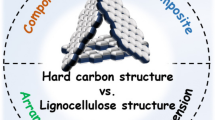Abstract
In this study, a novel method of hydrothermal electrolysis of microcrystalline cellulose (MCC) under sub-critical water conditions (200 °C) was investigated by applying direct current at constant voltage with the presence of acid catalyst of 5 mM H2SO4. Direct current at constant voltage of 2.5 V, 4.0 V and 8.0 V was applied between cylindrical anode (titanium) and cathode (reactor wall). Hydrothermal electrolysis reactions were carried out in a batch reactor (450 mL-T316) for the reaction time of 240 min. Decomposition products of MCC were analyzed by GC–MS and the decomposition pathway of cellulose under applied voltage was postulated. Levoglucosan and levoglucosenone formations were detected as the first hydrolysis products of MCC and further hydrolysis yielded to formation of glucose and fructose. The major decomposition products of cellulose were detected as levulinic acid (LA), 5-HMF and furfural. Further reactions of LA such as electrochemical decarboxylation, dehydration, hydrogenation, resulted in the formation of 2-butanone, 2-butanone-3-hydroxy, gamma-valerolactone, respectively. Most dramatic results on the product distribution were obtained at applied 2.5 V voltage in which LVA and 5-HMF were selectively produced.
Graphical abstract






Similar content being viewed by others
References
Akin O, Yuksel A (2016) Novel hybrid process for the conversion of microcrystalline cellulose to value-added chemicals: part 1: process optimization. Cellulose 23:3475–3493. https://doi.org/10.1007/s10570-016-1054-3
Akin O, Yuksel A (2017) Novel hybrid process for the conversion of microcrystalline cellulose to value-added chemicals: part 2: effect of constant voltage on product selectivity. Cellulose 24:4729–4741. https://doi.org/10.1007/s10570-017-1457-9
Amarasekara AS, Wiredu B (2015) Acidic ionic liquid catalyzed liquefaction of cellulose in ethylene glycol; identification of a new cellulose derived cyclopentenone derivative. Ind Eng Chem Res 54:824–831
Badgujar KC, Bhanage BM (2016) The green metric evaluation and synthesis of diesel-blend compounds from biomass derived levulinic acid in supercritical carbon dioxide. Biomass Bioenergy 84:12–21
Davis J, Baygents JC, Farrell J (2014) Understanding persulfate production at boron doped diamond film anodes. Electrochim Acta 150:68–74
dos Santos TR, Nilges P, Sauter W, Harnisch F, Schroder U (2015) Electrochemistry for the generation of renewable chemicals: electrochemical conversion of levulinic acid. RSC Adv 5:26634–26643
Kilic E, Yilmaz S (2015) Fructose dehydration to 5-hydroxymethylfurfural over sulfated TiO2–SiO2, Ti–SBA-15, ZrO2, SiO2, and activated carbon catalysts. Ind Eng Chem Res 54:5220–5225
Klemm D, Philipp B, Heinze T, Heinze U, Wagenknecht W (2004) General considerations on structure and reactivity of cellulose: section 2.1–2.1.4. In: Comprehensive cellulose chemistry. Wiley-VCH Verlag GmbH & Co. KGaA, New York, pp 9–29. https://doi.org/10.1002/3527601929.ch2a
Krishna SH, Walker TW, Dumesic JA, Huber GW (2017) Kinetics of levoglucosenone isomerization. ChemSusChem 10:129–138. https://doi.org/10.1002/cssc.201601308
Li H, Yang S, Riisager A, Pandey A, Sangwan RS, Saravanamurugan S, Luque R (2016) Zeolite and zeotype-catalysed transformations of biofuranic compounds. Green Chem 18:5701–5735. https://doi.org/10.1039/C6GC02415G
Marshall WL, Franck EU (1981) Ion product of water substance, O-Degrees-C–1000-Degrees-C, 1–10,000 bars: new international formulation and its background. J Phys Chem Ref Data 10:295–304
Nilges P, dos Santos TR, Harnisch F, Schroder U (2012) Electrochemistry for biofuel generation: electrochemical conversion of levulinic acid to octane. Energy Environ Sci 5:5231–5235
Sasaki M, Kabyemela B, Malaluan R, Hirose S, Takeda N, Adschiri T, Arai K (1998) Cellulose hydrolysis in subcritical and supercritical water. J Supercrit Fluid 13:261–268
Sasaki M, Fang Z, Fukushima Y, Adschiri T, Arai K (2000) Dissolution and hydrolysis of cellulose in subcritical and supercritical water. Ind Eng Chem Res 39:2883–2890
Sasaki M, Yamamoto K, Goto M (2007) Reaction mechanism and pathway for the hydrothermal electrolysis of organic compounds. J Mater Cycles Waste 9:40–46
Yuksel A, Sasaki M, Goto M (2011) Electrolysis reaction pathway for lactic acid in subcritical water. Ind Eng Chem Res 50:728–734
Zhang X, Yang W, Dong C (2013) Levoglucosan formation mechanisms during cellulose pyrolysis. J Anal Appl Pyrol 104:19–27. https://doi.org/10.1016/j.jaap.2013.09.015
Acknowledgments
Research is financially supported by Marie Curie Career Integration Grants (FP7-PEOPLE-2012-CIG) with a Project Number of PCIG11-GA-2012-321741. GC–MS analysis was conducted at ‘‘Environmental Reference Research and Development Center” at Izmir Institute of Technology.
Author information
Authors and Affiliations
Corresponding author
Additional information
Publisher's Note
Springer Nature remains neutral with regard to jurisdictional claims in published maps and institutional affiliations.
Rights and permissions
About this article
Cite this article
Akin, O., Yuksel, A. Novel hybrid process for the conversion of microcrystalline cellulose to value-added chemicals: part 3: detailed reaction pathway. Cellulose 26, 2999–3008 (2019). https://doi.org/10.1007/s10570-019-02291-6
Received:
Accepted:
Published:
Issue Date:
DOI: https://doi.org/10.1007/s10570-019-02291-6




